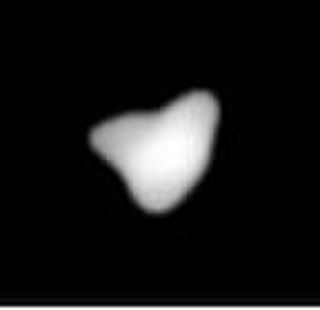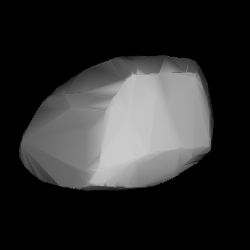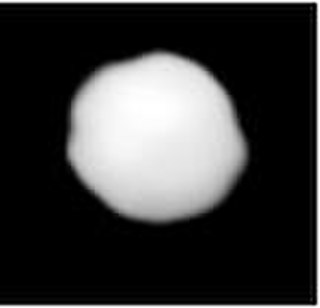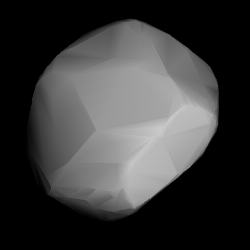
30 Urania is a large main-belt asteroid that was discovered by English astronomer John Russell Hind on July 22, 1854. It was his last asteroid discovery. This object is named after Urania, the Greek Muse of astronomy. Initial orbital elements for 30 Urania were published by Wilhelm Günther, an assistant at Breslau Observatory. It is orbiting the Sun with a period of 3.64 years and is spinning on its axis once every 13.7 hours.

109 Felicitas is a dark and fairly large main-belt asteroid. It was discovered by German-American astronomer C. H. F. Peters on October 9, 1869, and named after Felicitas, the Roman goddess of success. The only observed stellar occultation by Felicitas is one from Japan.

111 Ate is a main-belt asteroid discovered by the German-American astronomer C. H. F. Peters on August 14, 1870, and named after Ate, the goddess of mischief and destruction in Greek mythology. In the Tholen classification system, it is categorized as a carbonaceous C-type asteroid, while the Bus asteroid taxonomy system lists it as an Ch asteroid.

116 Sirona is a somewhat large and bright-colored main-belt asteroid that was discovered by the German-American astronomer C. H. F. Peters on September 8, 1871, and named after Sirona, the Celtic goddess of healing.

128 Nemesis is a large 180 km main-belt asteroid, of carbonaceous composition. It rotates rather slowly, taking about 78 hours to complete one rotation. Nemesis is the largest member of the Nemesian asteroid family bearing its name. It was discovered by J. C. Watson on 25 November 1872, and named after Nemesis, the goddess of retribution in Greek mythology.

145 Adeona is a large asteroid from the intermediate asteroid belt, approximately 150 kilometers in diameter. Its surface is very dark, and, based upon its classification as a C-type asteroid, is probably composed of primitive carbonaceous material. The spectra of the asteroid displays evidence of aqueous alteration. The Adeona family of asteroids is named after it.

160 Una is a fairly large and dark, primitive Main belt asteroid that was discovered by German-American astronomer C. H. F. Peters on February 20, 1876, in Clinton, New York. It is named after a character in Edmund Spenser's epic poem The Faerie Queene (1590). This minor planet is orbiting the Sun at a distance of 2.73 AU with an eccentricity of 0.07. The orbital plane is inclined at an angle of 3.83° to the plane of the ecliptic.

165 Loreley is a large main-belt asteroid that was discovered by C. H. F. Peters on August 9, 1876, in Clinton, New York and named after the Lorelei, a figure in German folklore. It is orbiting the Sun at a distance of 3.125 AU and a low eccentricity of 0.08. The orbital plane is inclined at an angle of 11.2° to the plane of the ecliptic.

194 Prokne is a main-belt asteroid that was discovered by German-American astronomer C. H. F. Peters on March 21, 1879, in Clinton, New York, and named after Procne, the sister of Philomela in Greek mythology. Stellar occultations by Prokne have been observed twice, in 1984 from Italy and again in 1999 from Iowa.

208 Lacrimosa is a main-belt asteroid that was discovered by Austrian astronomer Johann Palisa on October 21, 1879, in Pola. The name derives from Our Lady of Sorrows, a title given to Mary, the mother of Jesus. It is orbiting the Sun at a distance of 2.89320 AU with a period of 4.92 yr and an eccentricity (ovalness) of 0.013. The orbital plane is inclined at an angle of 1.7° to the plane of the ecliptic.

238 Hypatia is a large main-belt asteroid that was discovered by Russian astronomer Viktor Knorre on July 1, 1884, in Berlin. It was the third of his four asteroid discoveries. The name was given in honour of philosopher Hypatia of Alexandria. Based upon the spectrum, it is classified as a C-type asteroid and is probably composed of primitive carbonaceous material. Like many asteroids of this type, its surface is very dark in colour.

264 Libussa is a Main belt asteroid that was discovered by C. H. F. Peters on December 22, 1886, in Clinton, New York and was named after Libussa, the legendary founder of Prague. It is classified as an S-type asteroid.

308 Polyxo is a main-belt asteroid that was discovered by A. Borrelly on 31 March 1891, in Marseilles. It is orbiting the Sun at a distance of 2.75 AU with a low orbital eccentricity (ovalness) of 0.04 and a period of 4.56 yr. The orbital plane is tilted at an angle of 4.36° to the plane of the ecliptic.

334 Chicago is a very large main-belt asteroid. It is classified as a C-type asteroid and is probably composed of carbonaceous material.

350 Ornamenta is a relatively large main-belt asteroid, measuring 118 km in diameter. It is classified as a C-type asteroid and is probably composed of carbonaceous material.

386 Siegena is a very large main-belt asteroid. It is classified as a C-type asteroid and is probably composed of primitive carbonaceous material.
444 Gyptis is a main-belt asteroid that was discovered by J. Coggia on March 31, 1899, in Marseilles. It is classified as a C-type asteroid and is probably composed of carbonaceous material. The spectra of the asteroid displays evidence of aqueous alteration.

694 Ekard is a minor planet orbiting the Sun that was discovered by American astronomer Joel Hastings Metcalf on November 7, 1909. The asteroid's name comes from the reverse spelling of Drake University in Des Moines, Iowa, where Seth Barnes Nicholson and his wife calculated its orbit.
757 Portlandia is a main-belt asteroid 32 km in diameter. It was discovered on 30 September 1908 from Taunton, Massachusetts by the amateur American astronomer Joel E. Metcalf. The asteroid was named for the city of Portland, Maine, where Hastings was a church minister at the time. In November 2015, amateur astronomers captured it with images of comet 67P/Churyumov–Gerasimenko. Portlandia came to opposition in March 2016 at apparent magnitude 13.2.
914 Palisana, provisional designation 1919 FN, is a Phocaean asteroid from the inner regions of the asteroid belt, approximately 77 kilometers in diameter. It was discovered by German astronomer Max Wolf at Heidelberg Observatory on 4 July 1919.



















